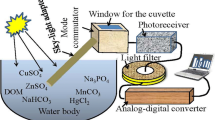Summary
The use of Fourier transform coherent optical techniques in the pattern recognition of microscopic algae, i.e., diatoms, is described. The results of the construction of complex-valued filters for diatoms and their usefulness in algal identification are presented. Some general applications to water pollution monitoring and control are discussed.
Similar content being viewed by others
References
Armitage, J. D., Lohmann, A. W.: Character recognition by incoherent spatial filter. Appl. Opt. 4, 461–467 (1965).
Cutrona, L. J., Leith, E. N., Palermo, C. J., Procello, L. J.: Optical data processing and filtering systems. I.R.E. Trans. on Information Theory IT 6, 386–400 (1960).
Elias, P., Grey, D. S., Robinson, D. Z.: Fourier treatment of optical processes. J. Opt. Soc. Amer. 42, 127–134 (1952).
Kozma, A., Kelley, D. L.: Spatial filtering of signals with additive noise. J. Opt. Soc. Amer. 54, 1395 (1964).
O'Neill, E. L.: Spatial filtering in optics. IRE P 6IT 2, 56 (1956).
Vander Lugt, A.: Signal detection by complex spatial filtering. Trans. IEEE IT 10, 139–145 (1964).
Author information
Authors and Affiliations
Rights and permissions
About this article
Cite this article
Cairns, J., Dickson, K.L., Lanza, G.R. et al. Coherent optical spatial filtering of diatoms in water pollution monitoring. Archiv. Mikrobiol. 83, 141–146 (1972). https://doi.org/10.1007/BF00425020
Issue Date:
DOI: https://doi.org/10.1007/BF00425020




